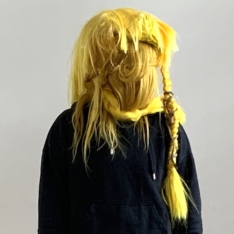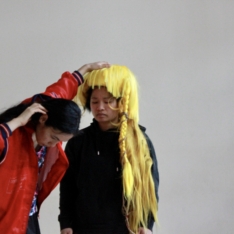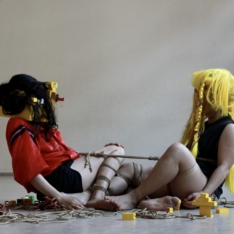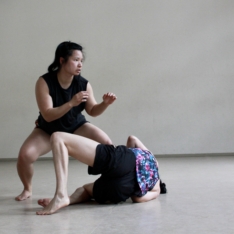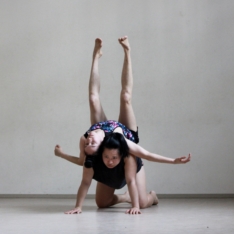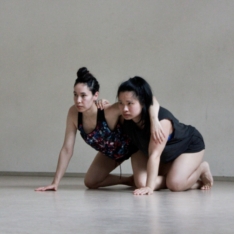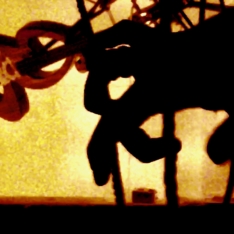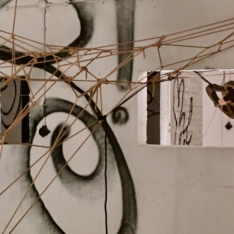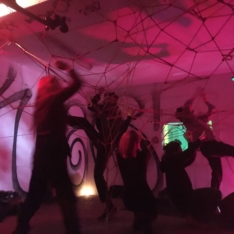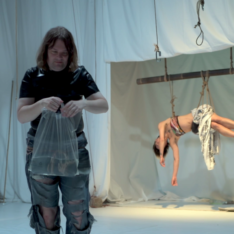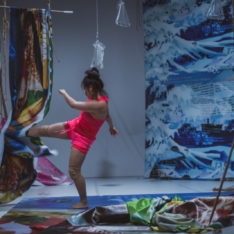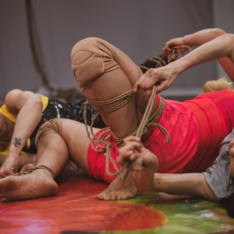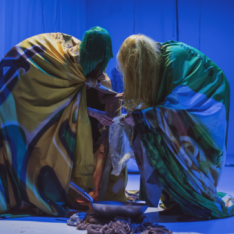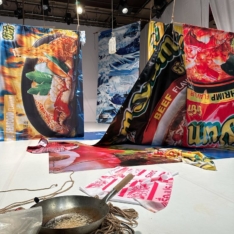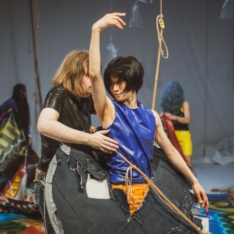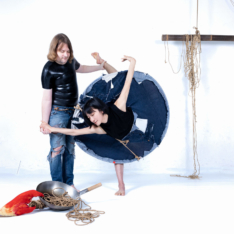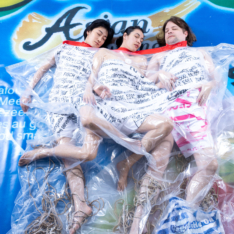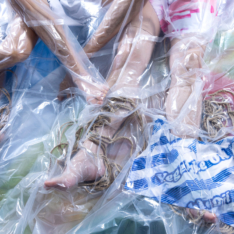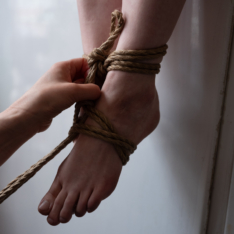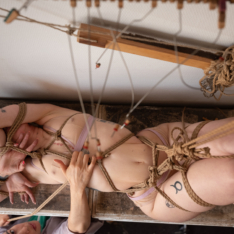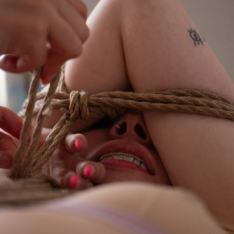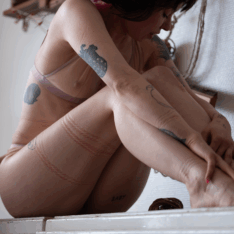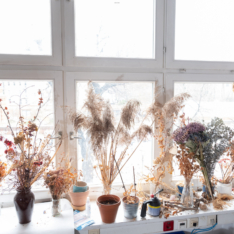Reasearching four weeks with Fungi Fung at Ada-Studio . Many thanks to:
Gabi Beier, Maria Ladopoulos and Liisi Hint!
And to our team:
‘Leichte Sprache’ translation and dramaturgical support: Manuel Gerst.
Outside eye: Clara Eckhardt and Akiles.
Critical companion: Melmun Bajarchuu.
There is an online stream of the performance on the Ada-site until Thursday March 21st.
And a text written by studio writer Maia Joseph.
Bondage
SHIBARI CLASSES NOVEMBER
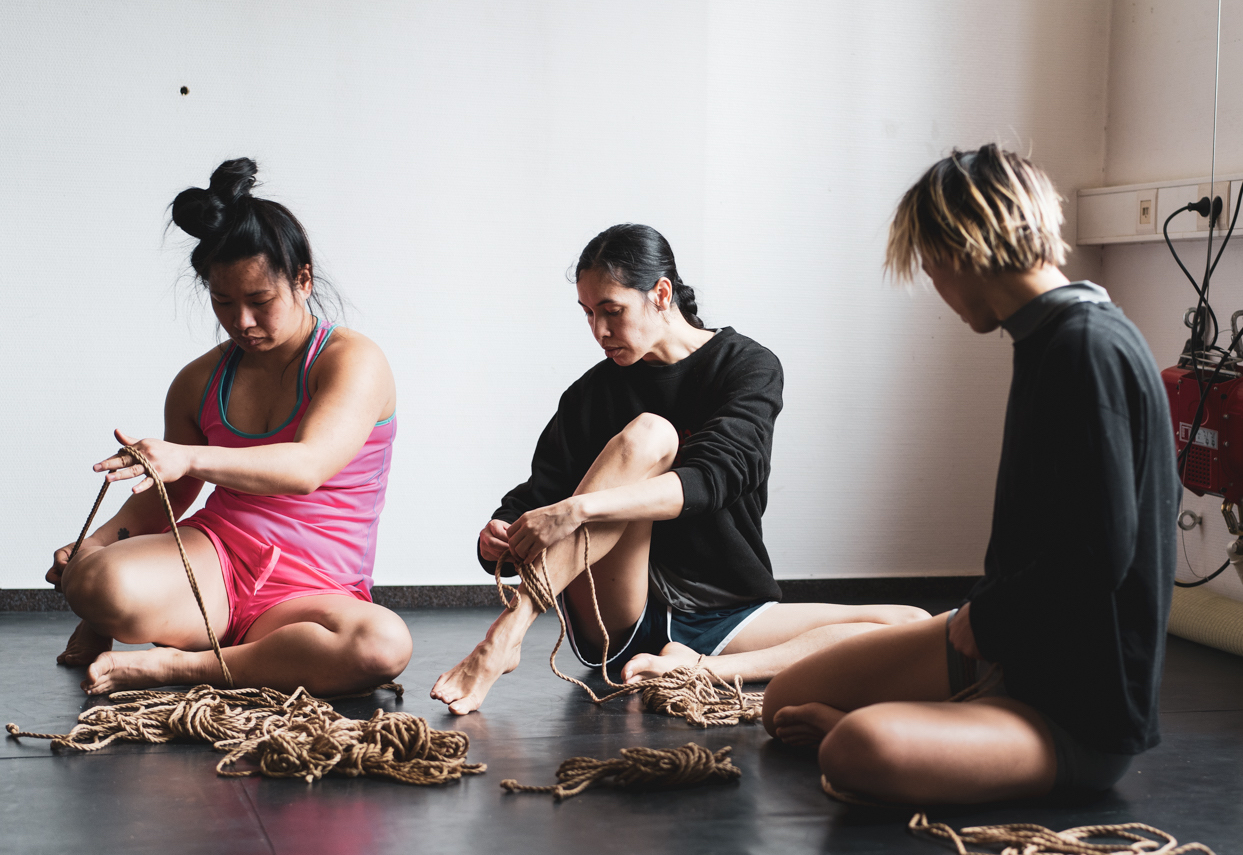 Tuesday November 7 + 21 + 28, 2023
Tuesday November 7 + 21 + 28, 2023
For more information please scroll up.
In the picture: Fungi, Dasniya and Tara photographed by Pippa Samaya.
Bunker Bondage
Joining this fun pilot project last minute: an interactive sound/rope installation at a former deep bunker in Friedrichshain from the 60ies. It was build for 250 people, several small rooms, and is now pretty run down and moist.
Both inspiring and irritating to bondage historical space, and during I was pondering about possible meanings. Is this how bunker architecture should be used, or exactly not?
But we only had two days. About the rope work it was most surprising that Keke and Wick managed to make the organic material sound. Jumping on the web and playing strings with fingers the audience co-created a sonic uncanny vibe. Thanks a lot to Keke (concept/sound) and Wick (cello) for inviting me. It was lovely to meet Taiga, tie with Natasha, and to add to Andy Buru’s ropy space ship.
SHIBARI CLASSES OCTOBER
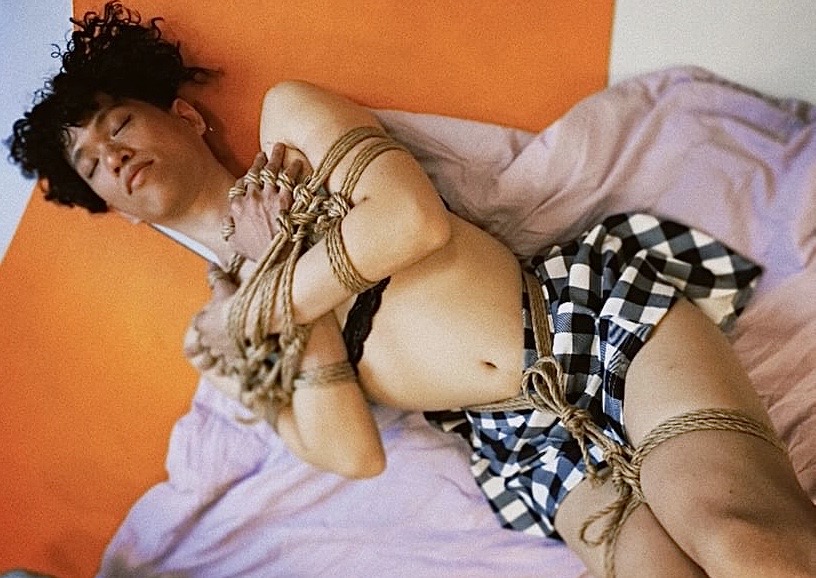
Tuesdays October 10th + 24th, 2023
For more information please scroll up.
In the picture: Lun tied and photographed by Gandalf during the ‘Dreaming’ workshop at Queer Rope Festival.
The Un-conference / Queer Rope Festival Berlin
Looking forward to teach two workshops at the Un-conference/ Queer Rope Festival by Karada House
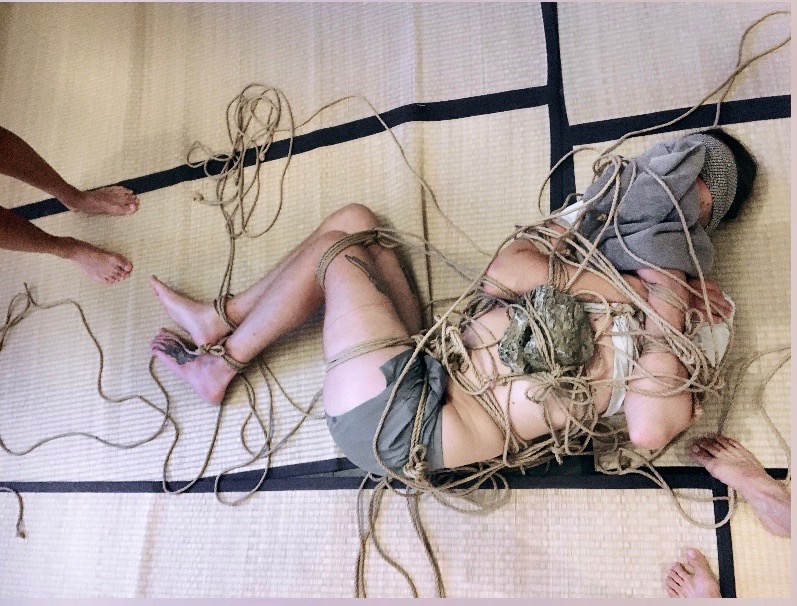
14.9.2023 – ‘Forrest’
The workshop focuses on creating a tying session for trios (co-topping). We begin with a demonstration using intermediate-level ties and upline technique. As there is no obligation to strictly follow a pattern participants are invited to work on individual levels and intensities which feel appropriate to the constellation. Exercises will include playful tools for moving and restricting the partner in space. And for timing, allowing sadistic fantasies to gradually unfold, as well as care impulses to build a session-like scenery.
We will include objects and organic materials such as stones, green or dry leaves, and plants/roots. Some material will be provided, but if possible please bring it along as well.
Teaching assistants: Gloria and Jonas.
15.9.2023 – ‘Dreaming’
This light intermediate technique class is for people who like to give their shoulders a rest from classical box harnesses. The hands front position allows for a longer, sexy play sessions on the floor without stressing nerves. To add intensity the lower body can lightly be suspended.
Model: Eliko.
For festival tickets go here.
Haus Sommer – Yum Yum
Premiere: May 12, 2023 at Ballhaus Ost .
In the picture: Michael Schumacher/Meine Damen und Herren Ensemble, Tara Jade Samaya, Yui Kawaguchi, Fungi Fung, Dasniya Sommer.
Documentation by Pippa Samaya.
Yum Yum – Tanzschreiber
Das nahrhafte Paradigma der Instant-Nudelsuppe
Das Ensemble-Stück „Yum Yum“ von Haus Sommer unter der Leitung der Choreografin und Tänzerin Dasniya Sommer, das vom 12.-14. Mai 2023 im Ballhaus Ost zu sehen ist, verwirrt vermeintlich Nicht-Zusammengehöriges und entwirrt dabei die Möglichkeiten von Künstlichkeit.
Es beginnt mit einer unerwarteten Erkenntnis: Ich habe noch nie YumYum-Nudeln gegessen. Während ich mich in die Einlassschlange zur Premiere des nach dem populären Instant-Gericht betitelten Stückes anstelle, denke ich ergebnislos über die Unkenntnis des Naheliegenden nach. Es wird nicht das letzte Mal an diesem Abend sein, dass mir etwas unbegreiflich bleibt. Drinnen wartet vor der Tribüne ein großer gemütlicher Teppich auf das Publikum, der in eine wunderliche Bühneninstallation buchstäblich ausfranst: Von der Decke hängen auf unterschiedlicher Höhe mehrere halbvoll mit Wasser gefüllte transparente Plastikbeutel, an den weißen Vorhängewänden lehnen einige lange Holzstäbe, im hinteren Teil der Bühne hängt ein riesiges Seilknäuel, das in Gedenken an die Überschrift der Aufführung sofort an Nudeln erinnert, und vorn am Bühnenrand steht, ebenfalls auf einem Haufen Seilbündel, ein großer Wok (Bühnenbild: Dasniya Sommer). In einer von meinem Platz aus kaum einsehbaren Nische am Bühnenrand wird eine der Performer*innen von drei anderen beiläufig verschnürt und auf eine suspension vorbereitet, während ein anderer Performer bedächtig zwischen den Wasserbeuteln umherläuft und dabei Worte vor sich hin spricht, die wahrscheinlich eine Zutatenliste ergeben. Jedes Mal, wenn sich mir etwas zu erhellen scheint, wird gleichzeitig etwas anderes undurchsichtig.
Im fünfköpfigen intersektionalen Ensemble von „Yum Yum“, das neben Sommer aus Michael Schumacher, Yui Kawaguchi, Tara Jade Samaya und Fungi Fung besteht, treffen unterschiedliche künstlerische Praktiken aufeinander: Schauspiel, Ballett, Mixed Martial Arts, zeitgenössischer Tanz und die japanische Fesselkunst Shibari. Damit ist bereits das Fundament gelegt für eine Ästhetik des Eklektischen, die immer wieder gängige Gegensätze in Frage stellt und dabei unerwartete Verknüpfungen generiert. In einer gleichsam poetisch wie brutal wirkenden Szene tanzen Sommer, Kawaguchi und Samaya eine Folge von Ballett-Schritten — haben dabei aber ihre Knie, ihre Arme vor der Brust oder ihre Hände hinter dem Rücken verbunden. Das kann als Kritik an der Disziplinierung des Körpers im Ballett gelesen werden, aber auch als Sinnlichkeit der Restriktion. In einem anderen Moment treten Sommer und Kawaguchi, deren Körper ich beide als asiatisch lese, als Nintendo-Marios mit Einkaufstüten-Tütü auf, die zu Game Boy-Musik eher bemüht als leichtfüßig eine Ballett-Choreografie tanzen (Sound Design, Composition: Nguyễn + Transitory). Damit unterlaufen sie einerseits Perfektionserwartungen, die sowohl ans Ballett als auch an asiatische Körper gestellt werden, und stellen gleichzeitig auf absurde Weise den dem Ballett zugrunde liegenden enorm artifiziellen Stil heraus, den es normalerweise unter dem hart erarbeiteten Schein von müheloser Natürlichkeit zu verstecken versucht. Während sich Schumacher daran macht, im Wok eine echte Nudelsuppe zuzubereiten, freue ich mich über das unverschämte Angebot, über Ballett als YumYum-Suppe nachzudenken.
Unter dem Flickenteppich der überall verteilten YumYum-Werbeplakate und der unterschiedlichen Szenen der Aufführung blitzt immer wieder das Thema antiasiatischer Rassismus auf. Sehr unumwunden drückt es sich in einem vielstimmigen Chor verschiedener marginalisierter Lebensrealitäten aus. Während die Aufnahme läuft und die Performer*innen die Bühne verlassen, verbinden sich Geschichten über Kochen und Essen mit denen über Arbeit und Migration. Doch auch der Auseinandersetzung mit den ästhetischen und vielleicht auch politischen Möglichkeiten von Künstlichkeit, die sich wie ein roter Faden durch „Yum Yum“ zieht, ist das Thema inhärent. Die Literaturwissenschaftlerin Anne Anlin Cheng, die zur langen Geschichte der Ästhetisierung des weiblichen asiatischen Körpers forscht, beschreibt das Potential von Künstlichkeit beispielsweise in fashion als „temporary relief from the burdens of having bodies and their inevitable weighty visibility“ insbesondere für rassifizierte Personen. Künstlichkeit kann ein Ort des Schutzes genauso wie der Gewalt sein, das führt auch das Stück immer wieder vor. Zum Schluss werden all die unzähligen Utensilien auf der Bühne zu einem riesigen Sack zusammengeschnürt, und die Performer*innen verschwinden unter voluminösen Perücken und langen Umhängen. Zu gespenstischer Musik im Dämmerlicht bleibt die Zeit stehen, und es verdampfen alle Differenzen zu einer für mich undefinierbaren Suppe voller überraschender ästhetischer Geschmacksrichtungen. Und so verdichtet sich all das Ungreifbare am Ende doch noch zu einer demütigen Erkenntnis für mich: meiner Unvertrautheit mit den mich umgebenden Alltagsrealitäten der asiatischen Diaspora. Dagegen helfen sicher auch keine Instant-Nudeln, wohl aber zeitintensive Performance-Zubereitungen wie dieser Abend.
„Yum Yum“ von Haus Sommer (Tanz/Choreografie/Bühnenbild: Dasniya Sommer; Tanz/Co-Choreografie/Performance: Michael Schumacher, Yui Kawaguchi, Tara Jade Samaya, Fungi Fung), Premiere: 12.05.2023, ist noch bis zum 14.05.2023 im Ballhaus Ost zu sehen, Tickets unter ballhausost.de.
Shibari Classes June
Wednesday June 7, 2023
Tuesday June 13 + 27, 2023
For more information on classes and workshops please scroll up.
Pictures in collaboration with Eliko (model) and Werner Aman (photos), ropes and space by Haus Sommer.
Haus Sommer – Yum Yum

Premiere
12.5.2023
Nächste Termine:
12.5.2023, 20:00
13.5.2023, 20:00
14.5.2023, 18:00
BALLHAUS OST
Pappel Allee 15
10437 Berlin /Prenzlauerberg
U2 Eberswalderstrasse
Strudel aus Verpackungsmüll zirkulieren im Ozean. Feminine Haie leuchten. Flinke Hände falten Oversize Origami. Seile werden zu Nudeln, zu Gedärmen, zu Geisternetzen. Care-Pas de Deux’ und Slow-food Porn treffen am Wok-Lagerfeuer einer thailändischen Megacity aufeinander. In der Tanzperformance entlädt sich der visuelle Kosmos einer glutamatgeschwängerten Fast Food Welt und aus eurozentristischer Sicht schwer verdauliche Lebensrealitäten führen rituell in absurde Gewässer.
Dasniya Sommer sucht mit Michael Schumacher vom inklusiven Ensemble Meine Damen und Herren, der MMA-Performerin Fungi Fung, der queer-ecologischen Tänzerin Tara Jade Samaya und Yui Kawaguchi Zusammenhänge zwischen Verdauung, Künstlichkeit und Kulturen. Mit Reflexionen über ‘Bodies of Water’ und Hydrofeminismus entsteht eine assoziative Bilderreise für eine kritische Auseinandersetzung mit Antiasiatischem Rassismus (und Exotismus).
Haus Sommer ist das Netzwerk-Label der Tänzerin und Choreographin Dasniya Sommer. In wechselnden Kollaborationen mit anderen Künstler:innen untersucht und erweitert sie die Formensprache klassischen Balletts unter dem Einfluss von Shibari, Body Art und zeitgenössischer Performance Kunst.
Shibari class April + May
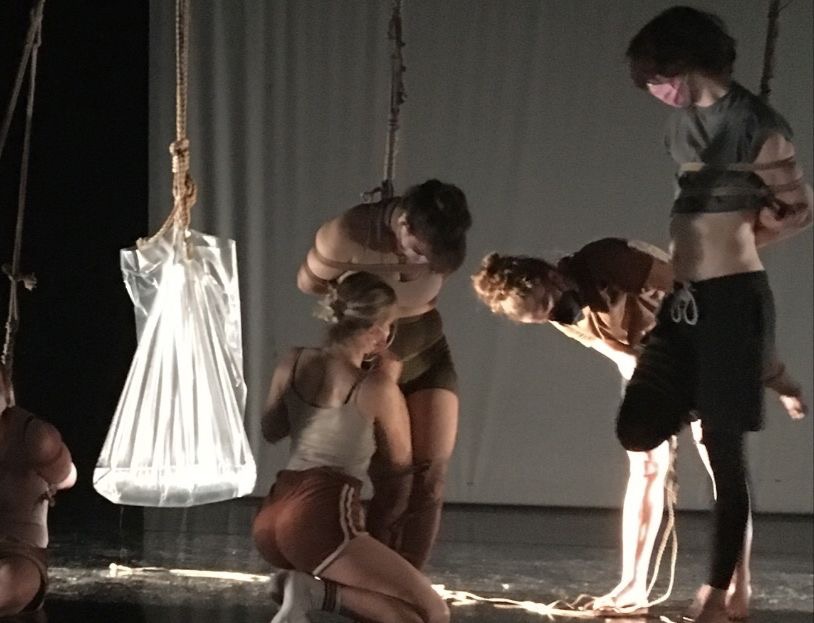
Tuesday April 18+25, 2023
Tuesday May 23, 2023
The course Beginner with Previous Experience is directed at learning the basics of Shibari/Kinbaku technique. We start systematically with efficient handling of body, rope, and safety principles (knots, wrapping and friction). The material contains a wide range of harnesses for floor work. Understanding restriction from the models perspective, and the complex skill set of the rigger, to create erotic phantasies or a meditative tie.
Scroll up for more information.
Foto: workshop presentation @HBK Braunschweig
